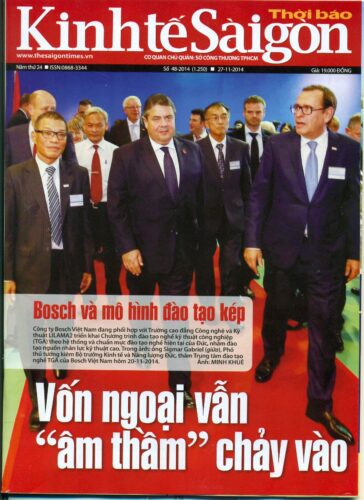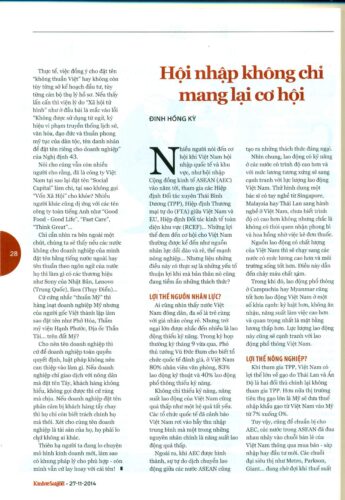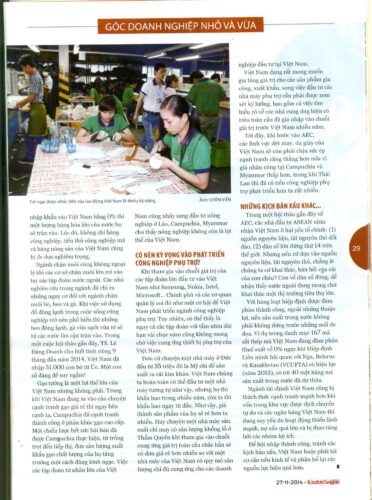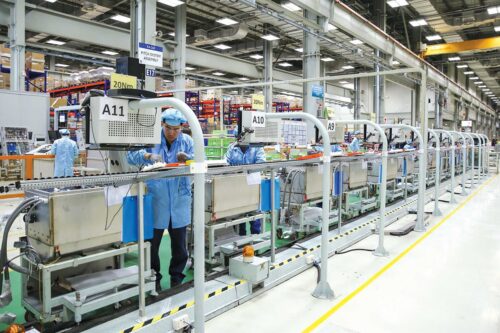Article by Mr. Dinh Hong Ky, published in Saigon Economic Times on November 27, 2014. Human resource advantage? Everyone can see that Vietnam has a large population, mostly young people, and cheap labor. But the biggest obstacle that is often mentioned is the lack of skilled labor. In the regular meeting last September, Deputy Prime Minister Vu Duc Dam said that international organizations assessed that in Vietnam, 80% of office workers, 83% of technical workers and 40% of unskilled workers lack skills.



Human resource advantages?
Everyone sees Vietnam as a populous country, with a young majority and cheap labor. But the biggest obstacle that is often mentioned is the lack of skilled labor. In the regular meeting last September, Deputy Prime Minister Vu Duc Dam said that international organizations assessed that in Vietnam, 80% of office workers, 83% of technical workers and 40% of unskilled workers lack skills.
Not only lacking skills, Vietnam’s labor productivity is also too low as an inevitable consequence. International organizations have warned that Vietnam is falling into the middle-income trap, one of the main reasons being too low labor productivity.
In addition, when the AEC is formed, the free movement of labor among ASEAN countries will also create formidable challenges.
In general, skilled workers in countries with higher qualifications and corresponding salaries will compete with the Vietnamese labor force. Imagine a skilled doctor from Singapore, Malaysia or Thailand coming to practice in Vietnam, not knowing if his qualifications are higher but probably not in the habit of receiving envelopes and commissions for prescribing drugs.
Vietnam’s quality labor force will go to countries with higher salaries and better living environments. This leads to a brain drain.
Meanwhile, unskilled labor in Cambodia or Myanmar is also better than Vietnamese labor in some aspects: more disciplined, no drinking, higher productivity and most importantly, lower salary. This labor force will also compete with unskilled labor in Vietnam.
Agricultural advantages?
When joining TPP, Vietnam has a big advantage in rice because Thailand and India, the two main competitors, are not participating in TPP. Moreover, the large rice consuming market, the US, will reduce the import tax on rice from Vietnam to the US from 7% to 0%.
However, also to prepare for AEC, ASEAN countries have rushed to jump into Vietnam’s retail chain through mergers and acquisitions or new investments. Supermarket chains such as Metro, Parkson, Giant… are waiting for the import tax rate to be 0% in Vietnam, then a large amount of goods from their countries will flood in. At that time, not only industrial and handicraft goods but also agricultural products of Vietnam will be seriously threatened.
The livestock industry is no exception when large livestock farms fall into the hands of foreign corporations. Industry researchers have pointed out the risks to the cattle, pig and chicken farming industries. When the use of frozen foods in industrial life becomes popular, frozen pigs and chickens that are both clean and cheap will flood in from neighboring countries. In a recent conference, Dr. Le Dang Doanh said that in the first 9 months of 2014 alone, Vietnam imported 51,000 cows from Australia. A number worth pondering!
Rice is thought to be a big advantage of Vietnam but it is not. While Vietnam is caught up in the story of competing for cheap rice, right next to us, Cambodia has successfully competed in the high-end rice segment.
A very methodical strategy has been implemented by Cambodia, from cultivation to marketing, bringing their quality rice export output to an astonishing growth. The fact that large private corporations in Vietnam have also jumped into investing in agriculture in Laos, Cambodia, and Myanmar shows that agriculture is no longer an advantage of Vietnam.
Should we expect the development of supporting industries?
When participating in the value chain of large corporations investing in Vietnam such as Samsung, Nokia, Intel, Microsoft… The government and management agencies consider it an opportunity for Vietnam to develop its supporting industry. However, it can be seen that even corporations with a long-term vision of several decades do not expect Vietnam to supply supporting equipment.
For example, a factory in Germany invested 35 million USD just to produce sewing needles. Vietnam can completely invest in a similar factory, but they depreciate over many years, while we depreciate from the beginning. Thus, their product cost will be much cheaper than ours. Or the story of a sewing thread factory with a huge output in Shenzhen, when participating in the global value supply chain, will certainly have a much cheaper unit price than a Vietnamese factory with an output scale only enough to supply businesses investing in Vietnam.
Vietnam is eager to increase the value of its processed and exported products, but investing in supporting factories needs to be carefully considered, including understanding existing global suppliers who have joined the value chain many years before Vietnam.
In the future, when entering the AEC, Vietnam’s textile, garment and footwear sectors will face even more intense competitive pressure because labor costs in Cambodia and Myanmar are lower, while Thailand has a much more developed supporting industry than ours.
Other bad scenarios…
In a recent workshop on the AEC, ASEAN investors viewed Vietnam in two main factors: (1) abundant raw materials and resources, (2) the 14th largest population in the world. But if we continue to rely on raw materials and resources, will we continue to exploit and sell all of our children’s wealth? As for the large population, it is easy to see that foreign countries are looking forward to exploiting a large consumer market.
With a series of successfully negotiated agreements, in addition to advantages, domestic production is not without threats. For example, in the list of 167 iron and steel codes that Vietnam is negotiating a 0% tax rate for as soon as the Customs Union Agreement with Russia, Belarus and Kazakhstan (VCUFTA) takes effect (2015), there are up to 40 items that have surplus domestic production.
Vietnam’s financial sector is also facing stronger competition challenges when capital in the region is freely transferred and Vietnamese banks are weakening due to unhealthy operations, too much bad debt and manipulation by interest groups.
To successfully integrate and avoid bad scenarios, Vietnam is forced to restructure the economy and reallocate resources more effectively.


